What issue can we solve for you?
Type in your prompt above or try one of these suggestions
Suggested Prompt


Research
The 2025 Generative AI Innovation Report
Bridging the gap between the C-suite and the V-suite
Get our latest insights
When ChatGPT launched on Nov. 30, 2022, generative AI exploded into the public consciousness. Less than two years later, it has transformed the world. Consumers and businesses alike use large language models (LLMs). Generative AI solutions fuel processes ranging from data management to software development.
But the generative AI revolution, like the original Industrial Revolution, is distributed. The spinning jenny emerged from the factory floor, not the board room, and it is practitioners, not the C-suite, who are driving innovation.
Our 2025 Generative AI Innovation Report found that the V-suite saw opportunities that the C-suite may well miss. But harnessing the power of a bottom-up approach requires confidence, courage, risk tolerance and people skills.
"Harnessing the power of a bottom-up approach requires confidence, courage, risk tolerance and people skills."
Daniel Liebermann , Managing Director at Publicis Sapient
Key Report Findings
-
The C-suite and V-suite see generative AI’s potential differently
The C-suite focused on more visible use cases such as customer experience, service and sales. In contrast, the V-suite sees opportunities across functional areas, including within operations, HR and finance.
They see its downsides differently, too
Fifty-one percent of C-level respondents were more concerned about the risk and ethics of generative AI than other emerging technologies, but just 23 percent of the V-suite shared their worries.
We’re at a shakeout moment
Return on investment (ROI) is important, with generative AI costs already a pain point for 27 percent of respondents, but there is still considerable uncertainty about how to measure success.
Nobody knows what maturity looks like
Because organizations can be at many different stages of generative AI maturity at the same time, there’s wide disagreement on what maturity looks like. Fifty-five percent of organizations that were building custom generative AI solutions described themselves as only of “moderate maturity” in generative AI and machine learning.
The state of AI in 2025
Generative AI maturity isn’t linear
Organizations can be at many levels of generative AI maturity simultaneously. More than one in five of those who were still in the process of defining generative AI use cases were already building custom generative AI tools.
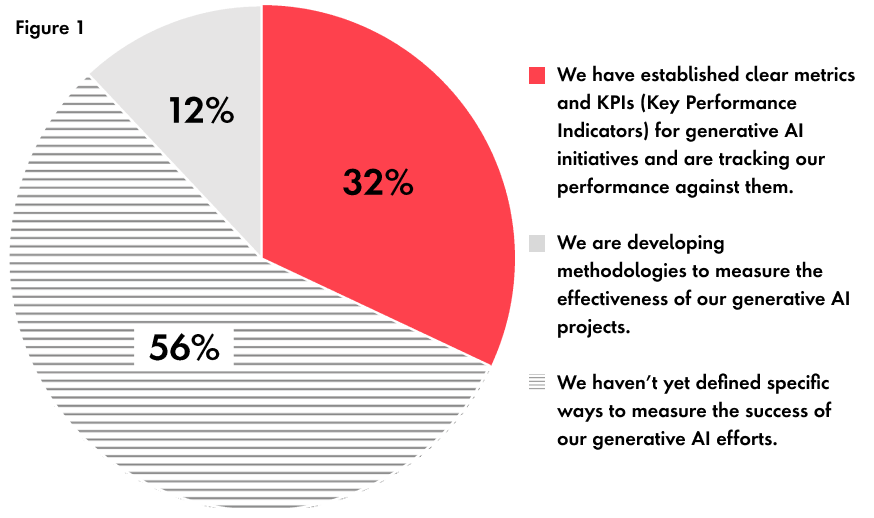

Few know what generative AI success looks like
More than two-thirds of respondents don’t yet have a way to measure the success of their generative AI projects, but 37 percent have a dedicated budget (Figure 1), according to the survey.
The percentage of respondents who ranked generative AI as “extremely important” to a functional area over the next three years
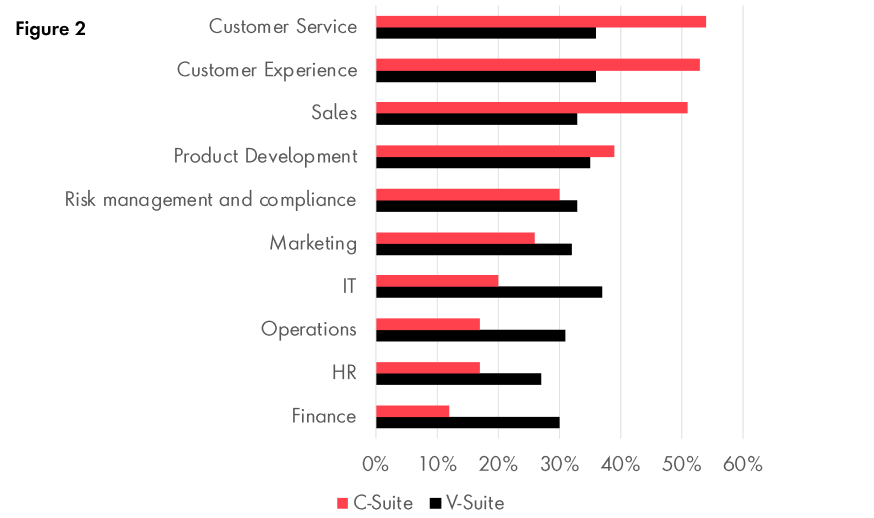

The V-suite sees back-office generative AI potential that the C-suite misses
More than half of C-suite respondents ranked generative AI as extremely important to customer service, customer experience and sales.
Just 12 percent of the C-suite thought generative AI would be extremely important in finance over the next three years, as opposed to 30 percent of their executives (Figure 2).
Top generative AI applications shaping C-suite and V-suite priorities for the next three years
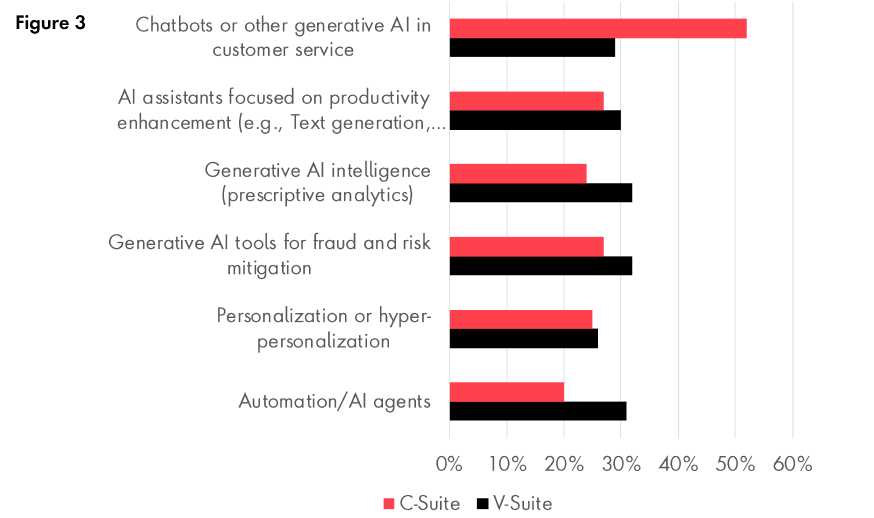

The V-suite is aware of generative AI tools the C-suite ignores
Almost 60 percent of CEOs thought chatbots and other generative AI tools would be extremely important in customer service, as opposed to just 24 percent of customer service specialist executives.
Just 17 percent of CEOs thought AI agents and automation would be extremely important, compared to 33 percent of data and analytics executives (Figure 3).
Proportion of respondents who were more concerned, similarly concerned and less concerned about the risk and ethics of generative AI than other emerging technologies
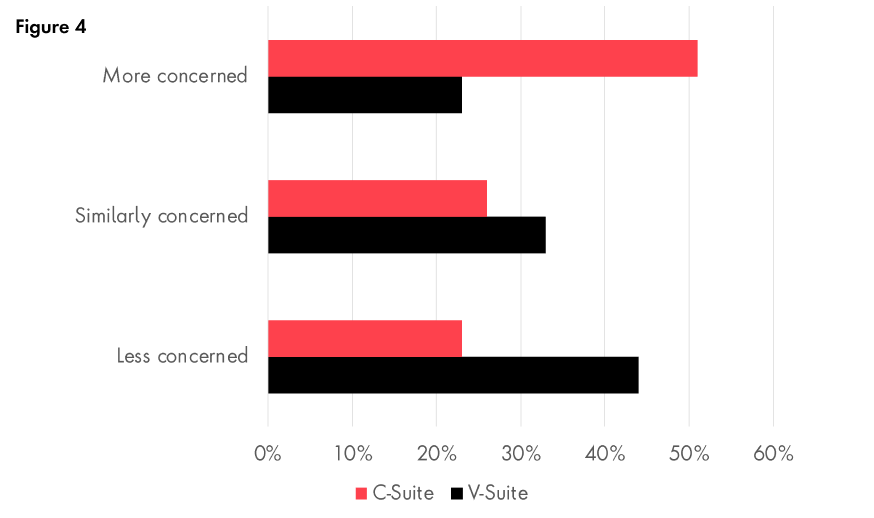

The C-suite and V-suite have different attitudes toward generative AI risk
The C-suite was more than twice as concerned about generative AI risk compared to the V-suite: 51 percent of the C-suite were more concerned about risk and ethics of generative AI than other emerging technologies, as opposed to just 23 percent of V-suite respondents (Figure 4).
Beyond chatbots: where generative AI is hiding in plain sight
More than 99 percent of respondents felt their organizations were making at least some progress with generative AI, even if it was only in defining use cases. From shopping assistants to content creation to contract generation, organizations and individuals are already using AI tools in their workflow. AI is integrated across many enterprises in transcription, translation and help with emails, spreadsheets and presentations.
But most experimentation is taking place far from the C-suite, so it’s as hard for leaders to learn how individuals within their organization are using ChatGPT or Microsoft Copilot as it is to understand how they’re using the internet. Many executives don’t know how far their organization is along the generative AI adoption journey.
Harnessing the power of this decentralized, bottom-up approach unlocks value—but presents real risks. Firstly, there is the danger of “shadow IT,” where different sections of the business create their own IT policy, leaving the organization exposed to reputational, regulatory and data security risks. Secondly, entities risk duplicating effort as different teams repeat projects colleagues have already attempted.
"It’s as hard for leaders to learn how individuals within their organization are using ChatGPT or Microsoft Copilot as it is to understand how they’re using the internet."
Daniel Liebermann , Managing Director at Publicis Sapient
Nobody knows what generative AI maturity looks like
Organizations that described themselves as of limited maturity were doing roughly the same things as organizations that described themselves as very mature.
Almost exactly the same percentage of limited maturity (35 percent) and very mature (34 percent) companies were initially exploring publicly available generative AI tools.
Similarly, 7 percent of organizations that described themselves as of limited maturity were already building their own custom generative AI solutions, and 13 percent of those that described themselves as very mature were doing the same, only a 6 percent difference (Figure 5).
How respondents' perceptions of their organization's maturity in generative AI aligned with their description of their organization's current level of generative AI implementation
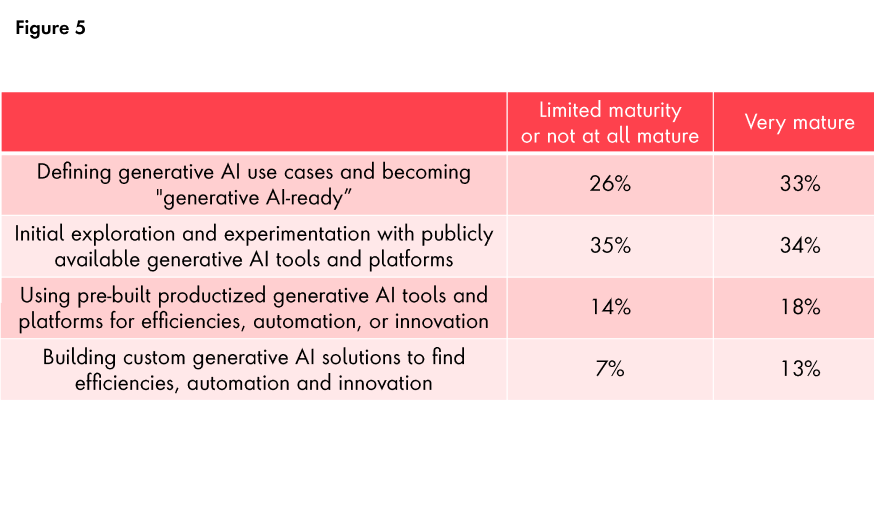
Leaders and practitioners see risk differently
Navigating a fast-changing regulatory and technological landscape with an unclear and uncertain risk profile can be frightening for executives—particularly CEOs. Approximately 70 percent of CEOs surveyed were more worried about the risks and ethics of generative AI than other emerging technologies.
It’s likely the C-suite is more worried about abstract, big-picture dangers, such as Hollywood-style scenarios of a rapidly evolving superintelligence, than the V-suite. After all, practitioners understand how high-maintenance and practically constrained the tech that underpins LLMs is.
But, while risks seem high and the short-term ROI may not always be evident, it’s important to get ahead of this new technology now. And, just like staking out your first e-commerce position 25 years ago, that’s likely to involve some failures as well as successes.
"Just like staking out your first e-commerce position 25 years ago, that’s likely to involve some failures."
Daniel Liebermann , Managing Director at Publicis Sapient
The portfolio approach is key to harnessing innovation energy
Transformative generative AI use cases the C-suite may ignore include synthetic data, data quality management, natural language search and software development. Generative AI search is yielding a veritable goldmine of data for early adopters, while synthetic data is informing decision-makers and customer choice algorithms alike.
To move forward with generative AI adoption, executives need to create a balanced portfolio of innovation projects rather than committing funds solely to flagship projects. Leaders should:
- Focus on projects that are delivering
- Control the shadow IT issue
- Avoid duplication of effort
- Empower domain experts to use their expertise
- Connect the business side of the organization to the CIO’s office
- Engage the risk office often and early
More broadly, organizations need to work to upskill people at all levels to maximize the value of generative AI in the enterprise—which is likely to change as the technology evolves. They need to encourage and motivate team members at all levels to seek out innovation and disruption and find opportunity in a rapidly changing world.
"Organizations need to encourage and motivate team members at all levels to seek out innovation and disruption."
Simon James , Vice President of Data & AI at Publicis Sapient
The five steps to maximize generative AI innovation in a bottom-up world
ONE
A zero-risk policy is a zero-innovation policy and executives must adopt a portfolio approach to generative AI strategy.
TWO
To ensure effective generative AI risk management, leaders should improve communication between the CIO’s office and the risk office.

THREE
The C-suite needs to actively seek out generative AI innovators and early adopters within their organization.
FOUR
Alongside traditional mechanisms such as a task force, an internal newsletter or a dedicated innovation arm, leaders can enlist the technology itself, using generative AI to create and manage information about generative AI.
FIVE
But every company’s solution will be unique, and empowering team members through company culture and upskilling is key to success.
"A zero-risk policy is a zero-innovation policy."
Simon James , Vice President of Data & AI at Publicis Sapient
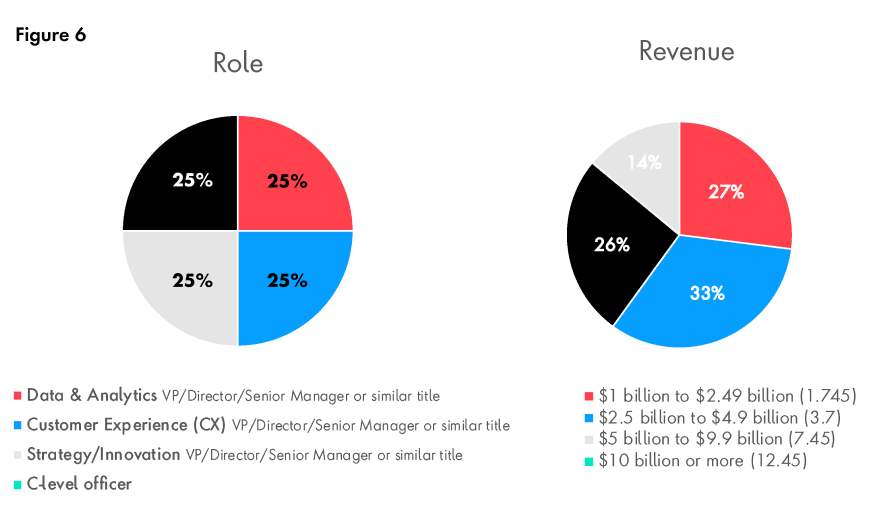

Methodology
iResearch conducted global online research in 12 countries across North America, Europe, Middle East and Asia Pacific in June and July 2024 to create this generative AI innovation report. Respondents were drawn evenly from consumer products, energy & commodities, financial services, healthcare, retail, telecommunications, media & technology (TMT), transportation & mobility and travel & hospitality. They worked for companies with an annual revenue between $1 billion and $10 billion dollars, either at the C-suite level or at the VP level in strategy and innovation, customer experience or data and analytics (Figure 6).
How Publicis Sapient can help
A successful generative AI approach is built on digital business transformation—and that is our core expertise. Our comprehensive Sapient AI solutions, leveraging proprietary AI tools like Sapient Slingshot and Bodhi and an AI-assisted agile approach, automate complex processes and elevate your organization’s potential. Wherever you are on your transformation journey, AI will shape your future—and we’re here to guide you. Recognized as a 2023 Market Leader in Generative Enterprise Services by HFS Research, our teams have deep experience designing and building innovative AI solutions. Together, we can unlock the full value of generative AI.
Related Reading
-
![]()
Insight
The Generative AI Risk Management Playbook
Most generative AI projects stall before launch. This guide reveals how to overcome common challenges and get your prototypes to production faster.
-
![]()
Insight
Sapient AI Solutions
Transform your business with tailored AI strategies designed to unlock unique value and drive digital innovation sustainably.
-
![]()
Insight
Marriott Transforms Vacation Home Search with Generative AI
Travelers describe their dream getaway, and the flexible search tool finds matching destinations and rentals.








